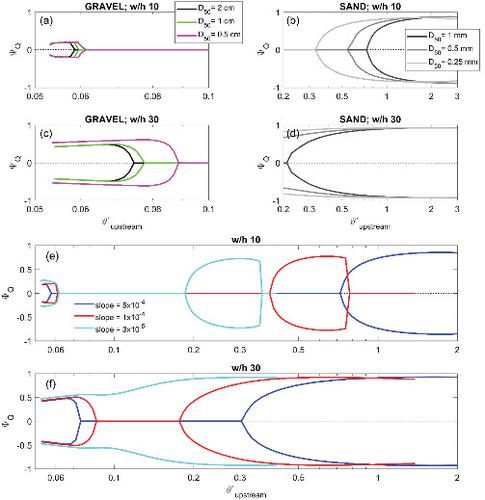当前位置:
X-MOL 学术
›
Earth Surf.Process. Land.
›
论文详情
Our official English website, www.x-mol.net, welcomes your feedback! (Note: you will need to create a separate account there.)
Effects of sediment grain size and channel slope on the stability of river bifurcations
Earth Surface Processes and Landforms ( IF 3.3 ) Pub Date : 2021-04-26 , DOI: 10.1002/esp.5141 Arya P. Iwantoro 1 , Maarten Vegt 1 , Maarten G. Kleinhans 1
Earth Surface Processes and Landforms ( IF 3.3 ) Pub Date : 2021-04-26 , DOI: 10.1002/esp.5141 Arya P. Iwantoro 1 , Maarten Vegt 1 , Maarten G. Kleinhans 1
Affiliation

|
Channel bifurcations can be found in river network systems from high gradient gravel-bed rivers to fine-grained low gradient deltas. In these systems, bifurcations often evolve asymmetrically such that one downstream channel silts up and the other deepens and, in most cases, they eventually avulse. Past analytical and numerical studies showed that symmetric bifurcations are unstable in high and low Shields stress conditions resulting in asymmetric bifurcations and avulsion, while they can be stable in the mid-Shields range, but this range is smaller for larger width-to-depth ratio. Here, using a one-dimensional (1D) numerical model, we show that effects of sediment grain size and of channel slope are much larger than expected for low-gradient systems when a sediment transport relation is used that separates between bedload and suspended load transport. We found that the range of Shields stress conditions with unstable symmetric bifurcations expanded for lower channel slopes and for finer sediment. In high sediment mobility, suspended load increasingly dominates the sediment transport, which increases the sediment transport nonlinearity and lowers the relative influence of the stabilizing transverse bedslope-driven flux. Contrary to previous works, we found another stable symmetric solution in high Shields stress, but this only occurs in the systems with small width-to-depth ratio. This indicates that suspended load-dominated bifurcations of lowland rivers are more likely to develop into highly asymmetric channels than previously thought. This explains the tendency of channel avulsion observed in many systems.
中文翻译:

沉积物粒度和河道坡度对河流分岔稳定性的影响
在从高坡度砾石床河流到细粒低坡度三角洲的河网系统中可以发现河道分叉。在这些系统中,分叉通常不对称地演变,使得一个下游通道淤塞,另一个加深,在大多数情况下,它们最终会撕裂。过去的分析和数值研究表明,对称分叉在高和低 Shields 应力条件下不稳定,导致不对称分叉和撕脱,而它们在中 Shields 范围内可以稳定,但对于较大的宽深比,该范围较小. 在这里,使用一维 (1D) 数值模型,我们表明,当使用沉积物输送关系将床载荷和悬浮载荷输送分开时,沉积物粒度和河道坡度的影响比低梯度系统的预期大得多。我们发现,对于较低的河道坡度和较细的沉积物,具有不稳定对称分叉的 Shields 应力条件的范围扩大了。在泥沙流动性大的情况下,悬浮荷载越来越多地主导泥沙输运,这增加了泥沙输运的非线性,降低了稳定横向床坡驱动通量的相对影响。与之前的工作相反,我们在高 Shields 应力下找到了另一种稳定的对称解决方案,但这仅发生在宽深比较小的系统中。这表明,以悬浮荷载为主的低地河流分叉比以前认为的更有可能发展成高度不对称的河道。这解释了在许多系统中观察到的通道撕脱的趋势。
更新日期:2021-04-26
中文翻译:

沉积物粒度和河道坡度对河流分岔稳定性的影响
在从高坡度砾石床河流到细粒低坡度三角洲的河网系统中可以发现河道分叉。在这些系统中,分叉通常不对称地演变,使得一个下游通道淤塞,另一个加深,在大多数情况下,它们最终会撕裂。过去的分析和数值研究表明,对称分叉在高和低 Shields 应力条件下不稳定,导致不对称分叉和撕脱,而它们在中 Shields 范围内可以稳定,但对于较大的宽深比,该范围较小. 在这里,使用一维 (1D) 数值模型,我们表明,当使用沉积物输送关系将床载荷和悬浮载荷输送分开时,沉积物粒度和河道坡度的影响比低梯度系统的预期大得多。我们发现,对于较低的河道坡度和较细的沉积物,具有不稳定对称分叉的 Shields 应力条件的范围扩大了。在泥沙流动性大的情况下,悬浮荷载越来越多地主导泥沙输运,这增加了泥沙输运的非线性,降低了稳定横向床坡驱动通量的相对影响。与之前的工作相反,我们在高 Shields 应力下找到了另一种稳定的对称解决方案,但这仅发生在宽深比较小的系统中。这表明,以悬浮荷载为主的低地河流分叉比以前认为的更有可能发展成高度不对称的河道。这解释了在许多系统中观察到的通道撕脱的趋势。



























 京公网安备 11010802027423号
京公网安备 11010802027423号